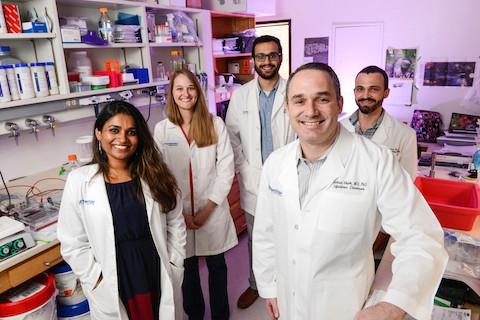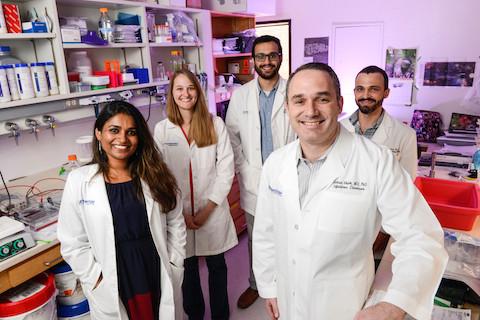
DALLAS – July 21 2016 – Researchers from UT Southwestern Medical Center have identified a new way that tuberculosis bacteria get into the body, revealing a potential therapeutic angle to explore.
One of the world's most deadly diseases, tuberculosis – primarily a lung disease – infects more than 8 million people and is responsible for 1.5 million deaths each year. According to the Centers for Disease Control and Prevention, approximately one-third of the world's population is infected with tuberculosis. The bacterium that causes tuberculosis, Mycobacterium tuberculosis, or Mtb, previously was thought to infect the body only through inhalation and subsequent infection of cells in the lungs.
The new study, published online today by Cell Reports, identifies an alternative route of entry that could have significant implications for the development of new therapies to prevent tuberculosis infection.
The research team, led by Dr. Michael Shiloh, Assistant Professor of Internal Medicine and Microbiology at UT Southwestern, found that microfold cell (M-cell) translocation is a new and previously unknown mechanism by which Mtb enters the body. M-cells are specialized epithelial cells that transport particles from the airway or mucosal surface to the compartment below the cell.
"The current model of disease is that when Mtb bacteria are inhaled, they reach the end of the lung – the alveolus – and then are ingested by a macrophage, a type of white blood cell that swallows and kills invading bacteria," Dr. Shiloh said. "Our study shows that once Mtb bacteria are inhaled, they also can enter the body directly through M-cells that line the airway tissue, and then travel to the lymph nodes and beyond. This is a key finding that suggests disease onset outside of alveolar macrophages is not only possible, but also important in the pathogenesis of tuberculosis infection."
Dr. Shiloh said that this mechanism of M-cell mediated movement of Mtb may help explain an ancient disease called scrofula. In this disease, tuberculosis infection rarely appears in the lung but instead causes disease in the lymph nodes of the neck.
Although further studies are necessary, potential clinical applications of the team's finding would involve developing methods or drugs that prevent Mtb from entering M-cells.
For example, Dr. Shiloh said, preventing Mtb from attaching to receptors on the M-cell surface – such as by vaccinating against a bacterial protein – could block the bacteria's entry, infection, and spread to other organs.
Dr. Shiloh and his team currently are working to discover the human cell-surface receptors for Mtb that are involved in the bacteria's M-cell translocation, as well as to determine the exact machinery used by the cell to move the bacteria from the surface to the bottom of the cell.
"We are taking several experimental approaches to identify the Mtb genes and proteins that are involved in this process," said Dr. Vidhya Nair, study lead author and a postdoctoral researcher in Internal Medicine.
In addition, because the investigators have data indicating that other important airway pathogens that cause acute bacterial pneumonia also may use M-cells to cause severe disease, they are extending their work beyond tuberculosis.
"Understanding these mechanisms in vivo would allow for targeted blockade of bacterial transport via vaccinations or medications, which could ultimately lead to new ways to prevent or treat airway infectious diseases," Dr. Shiloh explained.
###
Additional authors who contributed to this study were graduate students Haaris Khan and Chelsea Stamm; Dr. Luis Franco, Assistant Instructor in Internal Medicine; Dr. Denise Marciano, Assistant Professor of Internal Medicine; and Dr. Beth Levine, Director of the Center for Autophagy Research, a Howard Hughes Medical Institute Investigator, and holder of the Charles Cameron Sprague Distinguished Chair in Biomedical Science.
Researchers from Juntendo University School of Medicine in Tokyo, Japan, also contributed.
This study was supported by grants from the National Institutes of Health. In addition, Dr. Shiloh is a Disease-Oriented Clinical Scholar at UT Southwestern.
About UT Southwestern Medical Center
UT Southwestern, one of the premier academic medical centers in the nation, integrates pioneering biomedical research with exceptional clinical care and education. The institution's faculty includes many distinguished members, including six who have been awarded Nobel Prizes since 1985. The faculty of almost 2,800 is responsible for groundbreaking medical advances and is committed to translating science-driven research quickly to new clinical treatments. UT Southwestern physicians provide medical care in about 80 specialties to more than 92,000 hospitalized patients and oversee approximately 2.2 million outpatient visits a year.
Media Contact
Debbie Bolles
[email protected]
214-648-3404
@UTSWNews
http://www.swmed.edu





